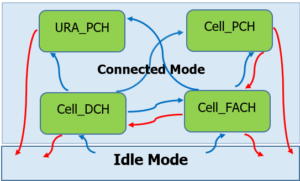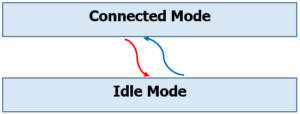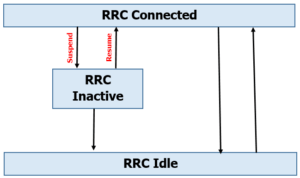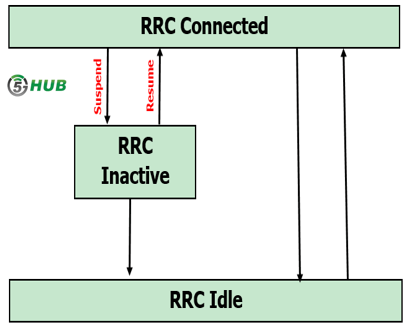Introduction
5G New Radio (NR) is designed to support the new Internet of Things (IoT) use cases such as critical control of remote devices and the performance of 5G is based on lessons learned from research and development on 3G and 4G networks.
One example of this relates to the transition of User Equipment (UE) from a power-saving state where data is not exchanged (idle state) to a connected state optimized for data transmissions (connected state).
Studies show that a UE’s transition from a power-saving (idle state) to a connected state is the most frequent high-layer signaling event in existing 4G LTE networks, occurring about 500-1000 times a day. So battery efficiency and duration will be essential, especially for those devices in remote locations and/or restricted areas.
RRC state transition in previous Generations (3G & 4G)
In 3G, the state machine consists of one idle mode state and four connected mode states [Cell_DCH, CELL_FACH, CELL_PCH, and URA_PCH] Fig (1).
The idle mode is optimized for low consumption of power and network resources but no UE RAN context is stored in the UE nor the network. However, the connected mode states are optimized for high UE activity and fast connection re-establishment. Accordingly, both the UE and the network store the UE’s RAN context.
However, the high number of RRC states, some with significantly overlapping characteristics, is complex to implement and increases the standardization effort.

Fig (1). 3G RRC State Transition
In 4G, the number of RRC states was scaled down to two, RRC Idle and RRC Connected Fig (2). The state machine is optimized for the Mobile Broadband (MBB) use case, as was the overall LTE design.
RRC Idle is optimized for low consumption of power and network resources. The UE’s Access Stratum (AS) context is discarded from the network and the UE upon transition to RRC Idle.
RRC Connected is optimized for high UE activity. However, the state machine is inefficient for infrequent transmissions of small packets due to the heavy signaling procedure required for RRC Idle to RRC Connected transition.

Fig (2). 4G RRC State Transition
RRC State Machine Lessons from existing systems (3G & 4G)
- The connected mode states CELL_FACH, CELL_PCH, and URA_PCH have similar characteristics with minor differences, targeting different levels of UE power consumption. For example, CELL_PCH and URA_PCH have similar characteristics except that the UE location is tracked on a cell level in CELL_PCH, while on the level of a group of cells in URA_PCH.
Considering the huge different number of 5G use cases, aiming at having multiple states, each optimized for different use cases, requires complex implementation and excessive standardization effort.
- In 4G, the re-establishment of the RAN/CN interface contributes a significant component to the overall control plane latency. For example, re-establishing RAN/CN connection contributes up to 68 % of the overall control plane latency in LTE.
Therefore, it is important to maintain the RAN/Core Network connection during low activity state.
RRC State Machine for 5G
A novel state model is proposed for the 5G Access enabling an efficient UE sleeping, a fast and lightweight transition from sleeping to active states and joint access optimizations Fig (3). The model consists of three states: RRC_IDLE, RRC_CONNECTED, and RRC_CONNECTED_INACTIVE (which is new).

Fig (3). 5G RRC State Transition
Why RRC_Connected_Inactive State?
The main principle of the inactive state is that the UE is able to return to the connected state as quickly and efficiently as possible. So it allows mitigating signaling overhead and the associated state transition latency, therefore reducing network resource cost for small traffic while extending at the same time the UE battery life.
The RRC INACTIVE state enables to:
- Quickly start the transmission of small data with low delay when the UE is in this RRC state.
- Minimize the required control signaling and the associated latency (comparably to the RRC_CONNECTED state).
- Minimize the UE power consumption.
- Minimize network resource costs in the RAN/CN (achieving similar levels as with the RRC IDLE state) making it possible to maximize the number of UEs utilizing and benefiting from this state.
RRC_Connected_Inactive State Operations
RRC Connected Inactivity state has two procedures as per Fig (3), Suspend procedure and Resume procedure.
Suspend Procedure
- UE and the RAN both sides store information about the UE transition from connected to inactive, along with the UE radio protocol configuration.
- The message that transitions the UE to an inactive state contains a set of parameters used for inactive state operation, such as a RAN Notification Area (RNA) within which the UE is allowed to move without notifying the network.
- Further, it includes parameters used for the secure transition back to the connected state, such as a UE identifier and security information needed to support encrypted resume messages.
The Resume procedure improves the transition from inactive to connected by restoring the UE radio protocol configuration.
RRC_Connected_Inactive State Characteristic
- The UE AS context is stored at the UE and in gNB.
- NR knows the RAN-based notification area in which the UE belongs to NR RRC states and transitions between them.
- UE behavior in RRC Connected Inactive state is configured based on the requirements of the applications running in the UE.
Conclusion
In 5G NR, it was proposed to introduce a new RRC state to complement the existing states, RRC_IDLE and RRC_CONNECTED.
The new state is referred to as RRC_INACTIVE and allows a UE to benefit from several aspects of the two original states.
It is designed primarily to enable optimized support of massive amounts of mMTC devices. It achieves that thanks to the reduction of control-plane signaling while balancing between battery efficiency and low latency when accessing the network (i.e. control-plane latency).
References
- Ericsson, Handling of inactive UEs, 2016, 3GPP RAN2#94.
- 2016 IEEE International Conference on Communications Workshops (ICC), A novel state model for 5G Radio Access Networks.
- 3GPP, “Interlayer procedures in Connected Mode (Release 13)”, TS 25.303
- Ericsson, A novel state model for 5G radio access networks.
- NGMN Alliance, “5G White Paper”, February 2015.














I learn something new and challenging on blogs I stumbleupon everyday.